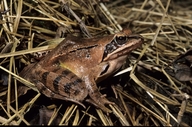|
Description
Vomerine teeth present. Posterior part of the tongue free and forked. Toes webbed. Omosternum and sternum ossified. Pupil of the eye horizontal. Body slender. Snout sharp. No male vocal sacs. Legs very long. Shin (knee to ankle) shorter than body by 1.46-1.86 times. When the shins are positioned perpendicularly to the body axis, the heels overlap. When the hind leg is stretched along the body, the tibio-tarsal articulation always exceeds the tip of snout. Inner metatarsal tubercle high and oval, 1.9-3.4 times shorter than the 1st toe. Flank and thigh skin smooth. Dorsal coloration yellowish, brown, greyish or rufous. chevron-shaped (^) dark glandular spot on neck. Dark spots on dorsal surface vary in number, arrangement and size. No spots on flanks. Temporal spot large. Belly white or white-pink, without pattern. Tympanum large and positioned very close to the eye. Nuptial pads on the first finger of the male during the breeding season grey to yellowish. No blue tints in male nuptial coloration. The species belongs to the 'brown frog' group of species.
Distribution and Habitat
Country distribution from AmphibiaWeb's database: Albania, Austria, Bosnia and Herzegovina, Bulgaria, Croatia, Czech Republic, Denmark, France, Germany, Greece, Hungary, Italy, Luxembourg, Macedonia, the Former Yugoslav Republic of, Montenegro, Poland, Romania, Serbia, Slovakia, Slovenia, Spain, Sweden, Switzerland, Turkey, Ukraine, United Kingdom. Introduced: Belgium.
The Agile Frog is widespread in Europe, from Southern Sweden (Oland Island) through Denmark, Northern France, Northeastern and Central Germany, parts of Austria, Hungary and the south of Ukrainian Carpathians. The species inhabits the Balkan Mountains southwards to the north of Asia Minor. The species is distributed very unevenly, being absent from a large areas within the range.
As a rule, the species inhabits leafed forests, consisting largely of oak and/or beech, hornbeam, ash etc. These forests often contain a thick layer of leaf litter. Reproduction occurs in well-illuminated and warm swamps in the forest or on forest edges. Such habitats are usually covered with dense herbaceous vegetation. In the south of its range, the species reproduces not only in stagnant but also in slowly running waters.
Life History, Abundance, Activity, and Special Behaviors
Rana dalmatina is active during the first half of the day and at twilight. During the reproductive period, it is active throughout the day and night. If the frog perceives danger, it escapes by very long, 1-2 m, and high, to 1 m, leaps. Hibernation starts at the end of September - end of October and lasts until late January - March. Reproduction usually occurs in March (sometimes February) to April. Breeding choruses are not formed. Amplexus is pectoral (axillary). The clutch contains 450-1800 eggs. Eggs are deposited at night on underwater vegetation in the most open parts of the pool. Metamorphosis occurs from late June to the beginning of August (and sometimes to October). Some tadpoles overwinter. Sexual maturity is probably attained in the third year of life; the maximum known age is 7 years. Adult R. dalmatina primarily consume terrestrial insects, whereas earthworms, spiders, myriapods etc. are rarely eaten.
Trends and Threats
In many sites the species has declined and some populations were extinct during the last decades. Habitat alteration seems to be the main threat for this species.
In the British Isles, R. dalmatina is restricted to Jersey. The species in this region had undergone such great decline that at one time it only bred in a single pond on the island. Efforts by Jersey environmental and conservation groups have successfully reintroduced breeding populations to several locations, including newly created and formerly occupied ponds (John W. Wilkinson & John Buckley, FrogLog 2012).
Relation to Humans
Although the frog lives in many anthropogenically changed landscapes, it seems to possess lower potential for synanthropization than many other brown frogs of the Palearctic.
Possible reasons for amphibian decline General habitat alteration and loss
Urbanization
References
Bannikov, A. G., Darevsky, I. S. and Rustamov, A. K. (1971). Zemnovodnye i Presmykayushchienya SSSR [Amphibians and Reptiles of the USSR]. Izdatelistvo Misl, Moscow.
Bannikov, A. G., Darevsky, I. S., Ishchenko, V. G., Rustamov, A. K., and Szczerbak, N. N. (1977). Opredelitel Zemnovodnykh i Presmykayushchikhsya Fauny SSSR [Guide to Amphibians and Reptiles of the USSR Fauna]. Prosveshchenie, Moscow.
Basoglu, M. and Ozeti, N. (1973). Turkiye Amphibileri. Ege Univ, Bornova-Izmir.
Gasc, J.-P. (1997). Atlas of Amphibians and Reptiles in Europe. Societas Europaea Herpetologica, Bonn, Germany.
Ishchenko, V.G. (1978). Dinamicheskii Polimophizm Burykh Lyagushek Fauny SSSR [Dynamic Polymorphism of the Brown Frogs of USSR Fauna]. Nauka, Moscow.
Ishchenko, V.G. and Ledentsov, A.V. (1985). ''[Ecological aspects of the postmetamorphic growth in Rana arvalis].'' Ekologicheskie Aspekty Skorosti Rosta i Razvitiya Zhivotnykh. Sverdlovsk.
Kuzmin, S. L. (1995). Die Amphibien Russlands und angrenzender Gebiete. Westarp Wissenschaften, Magdeburg.
Kuzmin, S. L. (1999). The Amphibians of the Former Soviet Union. Pensoft, Sofia-Moscow.
Nikolsky, A. M (1936). Fauna of Russia and Adjacent Countries: Amphibians (English translation of Nikolsky, 1918, Faune de la Russie et des Pays limitrophes. Amphibiens. Académie Russe des Sciences, Petrograd, USSR). Israel Program for Scientific Translations, Jerusalem.
Nikolsky, A. M. (1906). Herpetologia Rossica. Mémoires de l'Académie Impériale des Sciences de St.-Pétersbourg, Série 8, Phys.-Math, Vol. 17, Sofia, Moscow.
Nöllert, A. and Nöllert, C. (1992). Die Amphibien Europas. Franckh-Kosmos Verlags-GmbH and Company, Stuttgart.
Szczerbak, N. N. and Szczerban, M. I. (1980). Zemnovodnye i Presmykayushchiesya Ukrainskikh Karpat [Amphibians and Reptiles of Ukrainian Carpathians]. Naukova Dumka, Kiev.
Originally submitted by: Sergius L. Kuzmin, John Cavagnaro (first posted 1999-11-10)
Edited by: Meredith J. Mahoney (2012-04-02)Species Account Citation: AmphibiaWeb 2012 Rana dalmatina: Agile Frog <https://amphibiaweb.org/species/5016> University of California, Berkeley, CA, USA. Accessed Nov 25, 2024.
Feedback or comments about this page.
Citation: AmphibiaWeb. 2024. <https://amphibiaweb.org> University of California, Berkeley, CA, USA. Accessed 25 Nov 2024.
AmphibiaWeb's policy on data use.
|
